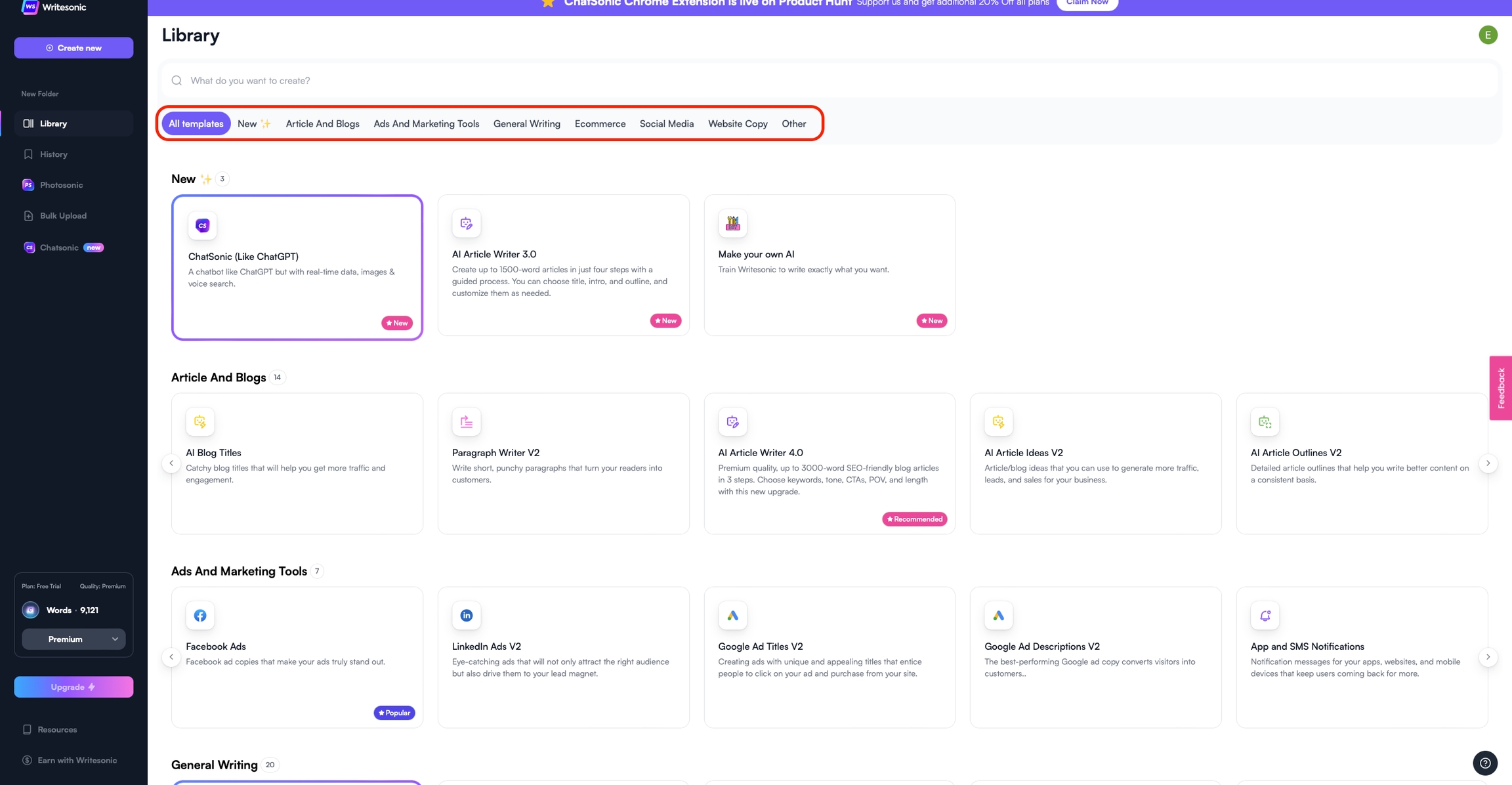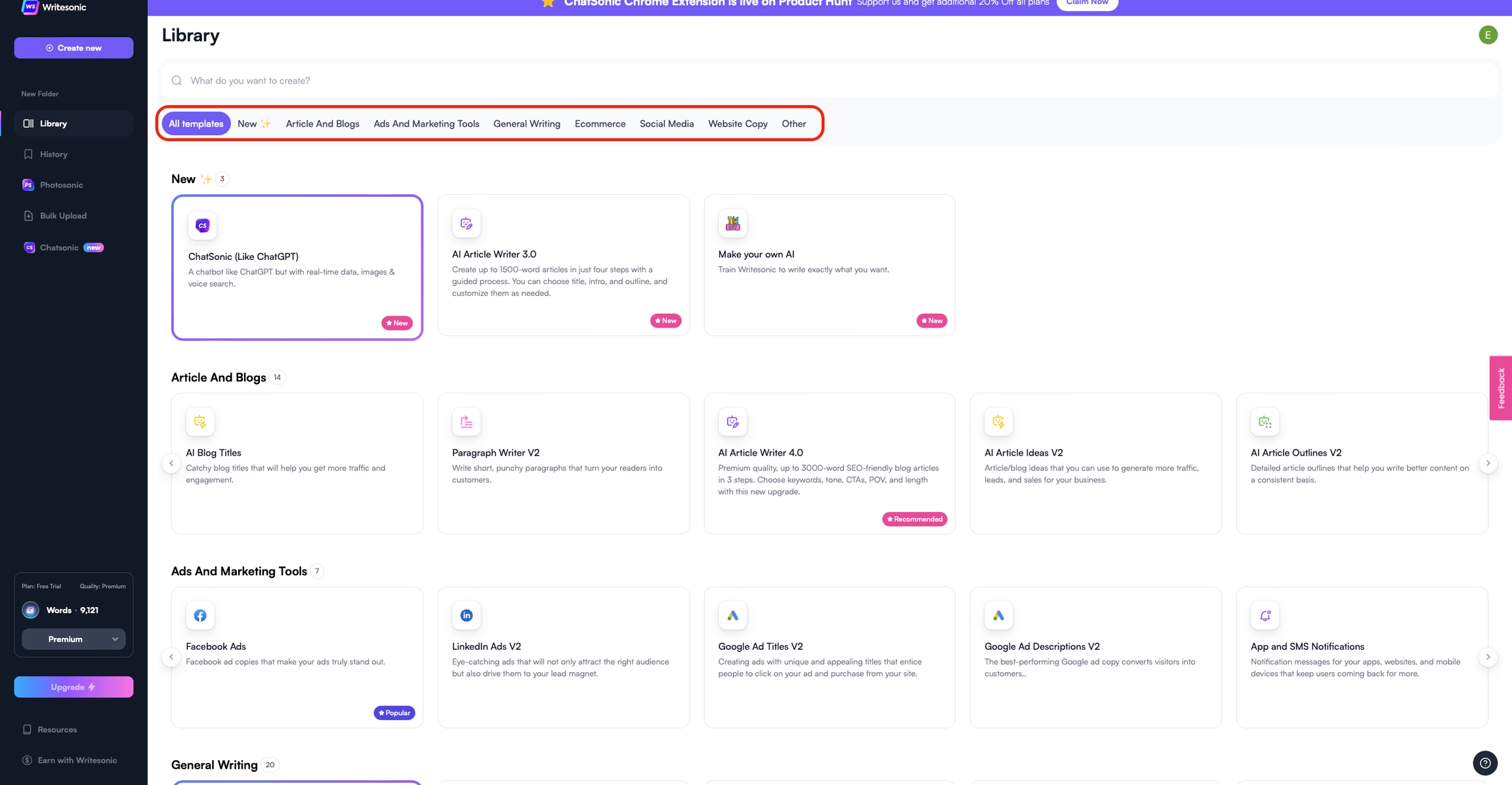WriteSonic
Author: Emir Olgun
Date: 13 March 2023
Introduction
WriteSonic is an AI platform for writing content. It has more than 65 features for different platforms and aims for users to crate high quality content in a short time. It is built on generative AI models. This AI is trained to generate content like ads and blog posts. With this tool, a writer can generate content that follows a specific brand's writing style, industry-specific content, SEO-optimized content and long articles.
Features
WriteSonic can be used for a wide variety of tasks. Some of these tasks are Facebook ads, Quora answers, tweets and Instagram captions.
How to Use
After signing-in you can try the free version which gives 10,000 words.

The highlighted area shows the categories. Choose the category you want and then you will enter the content generation page.

You can put the topic prompt, tone of voice, some keywords, language and the length of the content you want. For the example I tried, AI generated three outputs:
AI writing tools have rapidly become a popular and often necessary tool for content creators. These tools such as Jasper, WriteSonic, and ChatGPT can increase productivity, save time, and improve the quality of content. One of the significant advantages of AI writing tools is that they can create content that is both SEO and conversation optimized, making it easier for businesses to reach their target audience. These tools can help writers generate ideas, develop outlines, and even write entire articles with a click of a button. However, there are also some disadvantages to using AI writing tools. One of the most significant drawbacks is that the content created by these tools may lack a human touch. AI writing tools can only analyze data and create content based on that data. They cannot understand emotions, sarcasm, or irony, which can lead to poorly written content that lacks personality. Moreover, these tools may also struggle with complex topics and may not be able to write in a way that is suitable for the target audience. Another disadvantage of using AI writing tools is that they can be expensive. Some tools require a monthly subscription fee, which can add up over time, especially for small businesses or individuals. Additionally, there is always the risk of plagiarism when using AI writing tools. These tools may unintentionally copy content from other sources, leading to legal issues and damage to the reputation of the creator. In conclusion, AI writing tools can be a valuable asset for writers, but they also come with their own set of advantages and disadvantages. It is important to carefully consider the pros and cons before deciding to use these tools. Ultimately, it is up to the writer to determine whether the benefits outweigh the drawbacks and whether the content produced by AI writing tools aligns with their goals and values.
AI writing tools have revolutionized the world of content creation, making it faster, easier, and more efficient than ever before. These tools offer a wealth of advantages, such as increased productivity, enhanced creativity, and greater accuracy. For instance, Jasper is an AI-powered writing tool that can generate high-quality content within minutes. Its advanced algorithms can analyze data and produce custom-tailored content that meets specific requirements. Similarly, WriteSonic is another AI writing tool that can create compelling content for blogs, social media posts, and marketing copy. Its intuitive interface and user-friendly features make it easy to use for both novices and experts. ChatGPT is another AI-powered writing tool that can generate natural language text based on user input. By analyzing patterns and trends in data, it can generate content that is both informative and engaging. However, AI writing tools also have their fair share of disadvantages. One of the most significant drawbacks is the lack of human touch and creativity. While these tools can generate content quickly, they often lack the nuances and subtleties of human writing. Additionally, they may not be able to capture the tone or voice of a brand or individual as effectively as a human writer can. Another disadvantage is the potential for errors and inaccuracies. AI writing tools rely on algorithms and data analysis, which can sometimes lead to mistakes or inaccuracies in the final output. Lastly, AI writing tools can be expensive, and their cost may not be feasible for small businesses or individuals with limited budgets. In conclusion, AI writing tools offer a range of advantages and disadvantages that must be carefully considered before adopting them. While they can enhance creativity, productivity, and accuracy, they may also lack the human touch and creativity that is essential for effective content creation. Ultimately, it is up to individual users to decide whether the benefits of these tools outweigh the potential drawbacks.
Artificial intelligence (AI) writing tools have revolutionized the way content is created and marketed in the digital age. With programs like Jasper, WriteSonic, and ChatGPT, users can generate high-quality content for their websites, blogs, and social media platforms in a matter of minutes. The biggest advantage of using these AI writing tools is the significant time and effort savings they offer. With the help of AI writing tools, writers can focus on other important tasks while the tool generates content for them. These tools are also highly accurate and can produce content that is both SEO and conversation optimized, which can help drive traffic to your website and increase conversions. However, there are also some disadvantages to using AI writing tools. While they are highly effective, they lack the creativity and personal touch that come with human-written content. Additionally, AI writing tools may not always understand the nuances of language and context, which can lead to errors or misunderstandings. Another concern is the potential for these tools to be used to create fake or misleading content, which can have serious consequences for both individuals and society as a whole. Overall, AI writing tools like Jasper, WriteSonic, and ChatGPT are incredibly useful for creating high-quality content quickly and efficiently. However, it is important to be aware of their limitations and potential pitfalls to ensure that they are used ethically and responsibly. As with any technology, it is up to users to determine how best to leverage the benefits of AI writing tools while minimizing their drawbacks.
As you can see from the examples, WriteSonic can generate content with structure.
Conclusion
WriteSonic seems like a very useful tool that can be used for very different contents from social media to article generation. DAOs can use WriteSonic for generating tweets, instagram posts and internal articles and reports. The verification of generated content's informations should be done.
Additional Links
Last updated